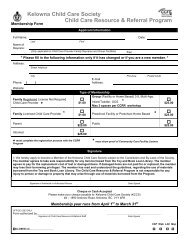ok parent mag 2011_12.pdf - Kelowna Child Care Society
ok parent mag 2011_12.pdf - Kelowna Child Care Society
ok parent mag 2011_12.pdf - Kelowna Child Care Society
Create successful ePaper yourself
Turn your PDF publications into a flip-book with our unique Google optimized e-Paper software.
<strong>Kelowna</strong> <strong>Child</strong> <strong>Care</strong> <strong>Society</strong> • <strong>2011</strong>/12 _14th ANNUAL EDITION<br />
The unknown can be more frightening<br />
to children than a move itself. So resist<br />
delaying news about the move; it will not<br />
reduce children’s anxiety. While wellmeaning,<br />
this may result in a child being overwhelmed<br />
by too swift a change. <strong>Child</strong>ren are<br />
likely to “eavesdrop” and learn of moving<br />
plans if you don’t tell them first. Give<br />
preschoolers at least a month’s notice so they<br />
can process information. Older children will<br />
appreciate even earlier notice.<br />
Once you decide to move, be truthful and<br />
straightforward. Explain things in simple, matterof-fact<br />
language. Discuss the move’s pros and<br />
cons. Otherwise, you’ll lose credibility and<br />
children’s trust, something they desperately<br />
need to cling to during big life changes.<br />
Leave pauses in conversations to give<br />
children a chance to ask questions. Make sure<br />
they know you’re willing to listen to them and<br />
discuss their viewpoint. And if it is true, reassure<br />
them that the whole family is moving together;<br />
no one will be left behind.<br />
As children react to news of the move, be empathetic and<br />
respect their feelings. Perhaps your child will express anger about<br />
moving. At first, you might be tempted to respond by saying,<br />
“You should be happy and grateful I’m trying to give you a nicer<br />
home.” That comment merely serves to alienate a child and<br />
induce guilt.<br />
Most times children simply need <strong>parent</strong><br />
assistance in sorting out and coping with feelings.<br />
A more supportive response helps children<br />
clarify their feelings, such as: “Moving is<br />
upsetting news to you. I wonder if you’re afraid<br />
you might not find new friends? Can you tell<br />
me about that?”<br />
That response acknowledges the child’s<br />
feelings and gives the child the permission to<br />
elaborate. By exploring and expressing feelings,<br />
children learn to manage and reconcile<br />
them. They also get a clearer view of what they<br />
can and cannot control.<br />
Below are other suggestions for preparing children for a<br />
move and helping them adjust after a move:<br />
• A move can drain children’s energy and interrupt<br />
concentration. When possible, avoid moving during stressful<br />
times - including near important family holidays.<br />
• Read good children’s bo<strong>ok</strong>s about moving. This prepares<br />
children and invites communication. Two of my favorites are:<br />
Alexander, Who’s Not (Do you hear me? I mean it?) Going to<br />
Move by Judith Viorst (New York: Antheneum Bo<strong>ok</strong>s for Young<br />
Readers, 1995) and A Tiger Called Thomas by Diana Cain<br />
Bluthenthal (New York: Hyperion Bo<strong>ok</strong>s for <strong>Child</strong>ren, 2003).<br />
• Rehearse upcoming events. <strong>Child</strong>ren can act out the move<br />
through pretend play with puppets, dolls, or stuffed animals.<br />
Old cardboard boxes can be “moving vans” and toy luggage<br />
storage for “treasures.”<br />
• After announcing the move, encourage children to write, tell,<br />
or draw a story of what he/she thinks might happen. This gives<br />
insight into your child’s perceptions and feelings. After hearing<br />
the story, you can confirm information or clear up misconceptions.<br />
Use the same technique after the move to encourage<br />
your child to continue expressing thoughts and feeling.<br />
• Help children gradually “warm up” to the move. Beforehand,<br />
tour the new neighborhood together. If you visit the new<br />
home or apartment, be sure to tell your child you’ll move your<br />
family’s belongings to the home so it will lo<strong>ok</strong> more familiar.<br />
Visit several times so children can gradually get acquainted.<br />
• Inform child care providers and teachers of the move so they<br />
know it may affect your child’s behavior. Ask them to contact<br />
you if they become concerned about your child’s adjustment.<br />
• Having some sense of control over events reduces children’s<br />
anxious feelings. Include children in moving preparations so<br />
they feel like competent, contributing family members.<br />
<strong>Child</strong>ren can help pack toy boxes or plan ways to make the<br />
family pet’s move more comfortable, too. <strong>Child</strong>ren can also<br />
help pick out bedroom colors and help plan how to arrange<br />
bedroom furniture.<br />
Moving to a new home and neighborhood will be one of<br />
your child’s first major life transitions. With your sensitive and<br />
responsive support, children will successfully meet the challenge.<br />
It’s a lesson that will serve them well for a lifetime.<br />
KAREN STEPHENS IS DIRECTOR OF ILLINOIS STATE UNIVERSITY CHILD CARE CENTER AND INSTRUCTOR<br />
IN CHILD DEVELOPMENT FOR THE ISU FAMILY AND CONSUMER SCIENCES DEPARTMENT. FOR NINE<br />
YEARS SHE WROTE A WEEKLY PARENTING COLUMN IN HER LOCAL NEWSPAPER.<br />
20 Celebrating 34 years of Community Service in the Central Okanagan!






